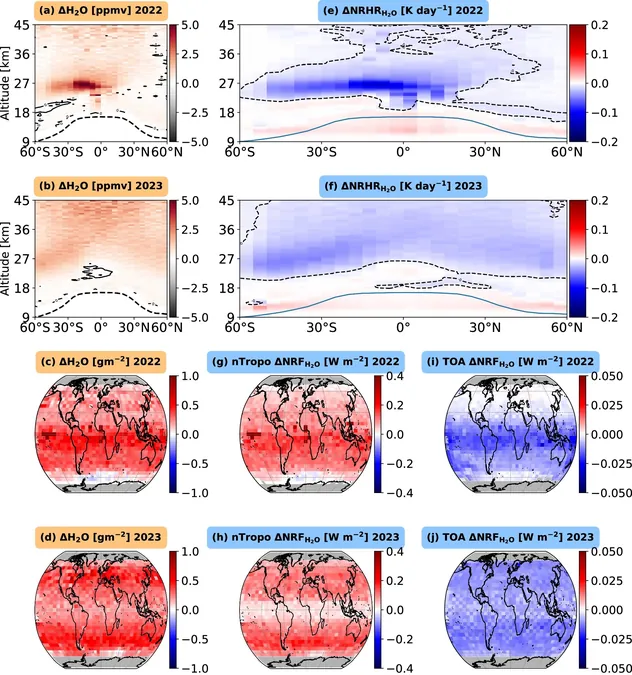
Shocking Revelations! Hunga Volcano's Eruption Cools Southern Hemisphere and Challenges Climate Change Strategies
2025-04-02
Author: Ming
Introduction
In an unexpected twist to climate science, the Hunga Tonga-Hunga Ha'apai underwater volcano's eruption in January 2022 not only spared the planet from warming effects but actually contributed to a significant cooling in the Southern Hemisphere, defying earlier assumptions about its impact. A groundbreaking study led by researchers at UCLA has revealed that this volcanic event led to a surprising decrease in temperatures by approximately 0.1°C.
Contrary to Expectations
Experts had previously anticipated that the eruption would release enough water vapor into the stratosphere to push global temperatures past the critical 1.5°C threshold outlined in the Paris Accords, leading to increased concerns about climate change. Instead, the eruption produced smaller sulfate aerosols, which had an efficient cooling effect that outweighed the warming potentially caused by water vapor. This new insight required scientists to reconsider how various atmospheric components interact, indicating that the atmospheric transformation is far more complex than previously understood.
Research Insights
UCLA atmospheric scientist Ashok Gupta, a leading author of the study published in *Communications Earth & Environment*, noted, “If we consider geoengineering strategies involving sulfate aerosols to reflect sunlight, we must account for various other factors, such as water vapor interactions, which could drastically alter the expected outcomes." His words raise alarms regarding the safety of climate intervention strategies that may carry unforeseen risks.
Volcanic Emissions and Their Effects
The Hunga Tonga eruption, which occurred from a vent just 200 meters below the ocean surface, released vast amounts of water vapor along with a moderate quantity of sulfur dioxide. This sulfur dioxide was quickly converted into microscopic sulfate aerosols. While sulfate aerosols generally promote cooling effects, water vapor — a potent greenhouse gas — inherently has warming effects, particularly at high altitudes. This complex interaction had scientists worried that the situation would exacerbate global warming.
Investigative Methods
Further investigations led by Gupta and a team from Vanderbilt University and Pennsylvania State University utilized state-of-the-art satellite data to track the dispersion of volcanic emissions and assess their influence on Earth's energy balance over the subsequent two years. Their findings revealed significant net radiative energy losses, signifying immediate cooling impacts at both the top of the atmosphere and the tropopause.
Significant Findings
Remarkably, the study found that the sulfate aerosols were roughly 50% smaller than those produced by the infamous Mount Pinatubo eruption in 1991, making them more effective at blocking sunlight. This finding was pivotal as it highlighted that smaller particles have erratic movements that enhance their chances to reflect sunlight, thus producing a cooling effect.
Looking Ahead
Although a minor warming trend was detected in the Northern Hemisphere, attributed to lingering water vapor, the overall evidence pointed towards a slight cooling brought about by the Hunga eruption. Gupta asserted that understanding geoengineering's multiple consequences is imperative for shaping future climate interventions. This study serves as a crucial warning; any geoengineering efforts must come equipped with a comprehensive understanding of atmospheric dynamics to prevent unintended warming or other adverse effects.
Conclusion
The Hunga volcano's eruption represents a scientific crossroads in climate response strategies. As the world grapples with climate challenges, this new research provokes essential questions about the efficacy and safety of potential geoengineering solutions. With global temperatures continuing to rise, understanding these complex atmospheric interactions is more critical than ever. Stay tuned as scientists unravel more about the implications of such volcanic activities on climate change.

 Brasil (PT)
Brasil (PT)
 Canada (EN)
Canada (EN)
 Chile (ES)
Chile (ES)
 Česko (CS)
Česko (CS)
 대한민국 (KO)
대한민국 (KO)
 España (ES)
España (ES)
 France (FR)
France (FR)
 Hong Kong (EN)
Hong Kong (EN)
 Italia (IT)
Italia (IT)
 日本 (JA)
日本 (JA)
 Magyarország (HU)
Magyarország (HU)
 Norge (NO)
Norge (NO)
 Polska (PL)
Polska (PL)
 Schweiz (DE)
Schweiz (DE)
 Singapore (EN)
Singapore (EN)
 Sverige (SV)
Sverige (SV)
 Suomi (FI)
Suomi (FI)
 Türkiye (TR)
Türkiye (TR)
 الإمارات العربية المتحدة (AR)
الإمارات العربية المتحدة (AR)